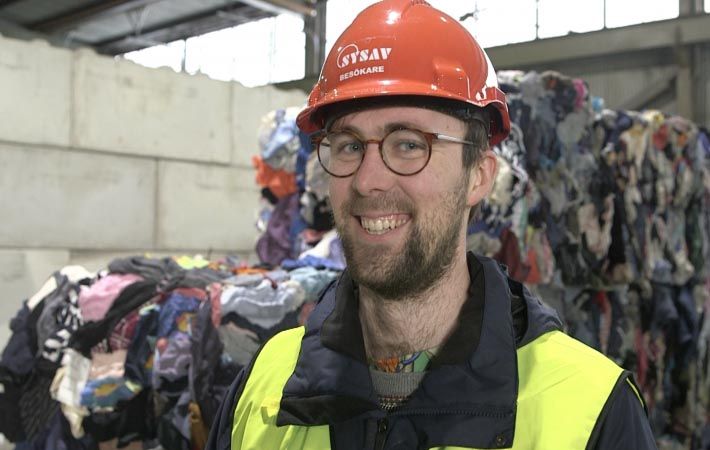Interviews
Swedish scientists convert cotton into sugar, to make textiles
08 Mar '21
4 min read

Pic: Lund University
In a major step towards recycling, scientists at Sweden’s Lund University have found a way to convert cotton into sugar, which in turn can be made into spandex, nylon or ethanol. Every year, an estimated 25 million tonnes of cotton textiles are discarded around the world. In total, 100 million tonnes of textiles are thrown out. A lot ends up in landfills.
In Sweden, most of the discarded material goes straight into an incinerator and becomes district heating. In other places, it is even worse, as clothes usually end up in landfills.
“Considering that cotton is a renewable resource, this is not particularly energy-efficient,” says Edvin Ruuth, researcher in chemical engineering at Lund University. “Some fabrics still have such strong fibres that they can be re-used. This is done today and could be done even more in future. But a lot of the fabric that is discarded has fibres that are too short for re-use, and sooner or later all cotton fibres become too short for the process known as fibre regeneration.”
At the Department of Chemical Engineering in Lund where Edvin Ruuth works, there is a great deal of information about using micro-organisms and enzymes to transform the “tougher” carbohydrates in biomass into simpler molecules. This means that everything from biological waste and black liquor to straw and wood chips can become bioethanol, biogas and chemicals.
In the new research, scientists have succeeded in breaking down the plant fibre in cotton – the cellulose – into smaller components. However, no micro-organisms or enzymes are involved. Instead, the process involves soaking the fabrics in sulphuric acid. The result is a clear, dark, amber-coloured sugar solution.
“The secret is to find the right combination of temperature and sulphuric acid concentration,” explains Ruuth, who fine-tuned the ‘recipe’ together with doctoral student Miguel Sanchis-Sebastiá and professor Ola Wallberg.
Glucose is a very flexible molecule and has many potential uses, according to Ruuth. “Our plan is to produce chemicals which in turn can become various types of textiles, including spandex and nylon. An alternative use could be to produce ethanol.”
From a normal sheet, they extract five litres of sugar solution, with each litre containing the equivalent of 33 sugar cubes. However, you couldn’t turn the liquid into a soft drink as it also contains corrosive sulphuric acid.
One of the challenges is to overcome the complex structure of cotton cellulose.
“What makes cotton unique is that its cellulose has a high crystallinity. This makes it difficult to break down the chemicals and reuse their components. In addition, there are a lot of surface treatment substances, dyes and other pollutants which must be removed. And structurally, a terrycloth towel and an old pair of jeans are very different,” says Ruuth.
“Thus, it is a very delicate process to find the right concentration of acid, the right number of treatment stages and temperature,” Ruuth adds.
The concept of hydrolysing pure cotton is nothing new per se, explains Ruuth - it was discovered in the 1800s. The difficulty has been to make the process effective, economically viable and attractive. “Many people who tried ended up not utilising much of the cotton, while others did better but at an unsustainable cost and environmental impact.”
When he started making glucose out of fabrics a year ago, the return was a paltry three to four per cent. Now he and his colleagues have reached as much as 90 per cent. Once the recipe formulation is complete, it will be both relatively simple and cheap to use.
However, for the process to become a reality, the logistics must work. There is currently no established way of managing and sorting various textiles that are not sent to ordinary clothing donation points.
A recycling centre unlike any other in the world is currently under construction in Malmö, where clothing is sorted automatically using a sensor. Some clothing will be donated, rags can be used in industry and textiles with sufficiently coarse fibres can become new fabrics. The rest will go to district heating. Hopefully, the proportion of fabrics going to district heating will be significantly smaller once the technology from Lund is in place.
In Sweden, most of the discarded material goes straight into an incinerator and becomes district heating. In other places, it is even worse, as clothes usually end up in landfills.
“Considering that cotton is a renewable resource, this is not particularly energy-efficient,” says Edvin Ruuth, researcher in chemical engineering at Lund University. “Some fabrics still have such strong fibres that they can be re-used. This is done today and could be done even more in future. But a lot of the fabric that is discarded has fibres that are too short for re-use, and sooner or later all cotton fibres become too short for the process known as fibre regeneration.”
At the Department of Chemical Engineering in Lund where Edvin Ruuth works, there is a great deal of information about using micro-organisms and enzymes to transform the “tougher” carbohydrates in biomass into simpler molecules. This means that everything from biological waste and black liquor to straw and wood chips can become bioethanol, biogas and chemicals.
In the new research, scientists have succeeded in breaking down the plant fibre in cotton – the cellulose – into smaller components. However, no micro-organisms or enzymes are involved. Instead, the process involves soaking the fabrics in sulphuric acid. The result is a clear, dark, amber-coloured sugar solution.
“The secret is to find the right combination of temperature and sulphuric acid concentration,” explains Ruuth, who fine-tuned the ‘recipe’ together with doctoral student Miguel Sanchis-Sebastiá and professor Ola Wallberg.
Glucose is a very flexible molecule and has many potential uses, according to Ruuth. “Our plan is to produce chemicals which in turn can become various types of textiles, including spandex and nylon. An alternative use could be to produce ethanol.”
From a normal sheet, they extract five litres of sugar solution, with each litre containing the equivalent of 33 sugar cubes. However, you couldn’t turn the liquid into a soft drink as it also contains corrosive sulphuric acid.
One of the challenges is to overcome the complex structure of cotton cellulose.
“What makes cotton unique is that its cellulose has a high crystallinity. This makes it difficult to break down the chemicals and reuse their components. In addition, there are a lot of surface treatment substances, dyes and other pollutants which must be removed. And structurally, a terrycloth towel and an old pair of jeans are very different,” says Ruuth.
“Thus, it is a very delicate process to find the right concentration of acid, the right number of treatment stages and temperature,” Ruuth adds.
The concept of hydrolysing pure cotton is nothing new per se, explains Ruuth - it was discovered in the 1800s. The difficulty has been to make the process effective, economically viable and attractive. “Many people who tried ended up not utilising much of the cotton, while others did better but at an unsustainable cost and environmental impact.”
When he started making glucose out of fabrics a year ago, the return was a paltry three to four per cent. Now he and his colleagues have reached as much as 90 per cent. Once the recipe formulation is complete, it will be both relatively simple and cheap to use.
However, for the process to become a reality, the logistics must work. There is currently no established way of managing and sorting various textiles that are not sent to ordinary clothing donation points.
A recycling centre unlike any other in the world is currently under construction in Malmö, where clothing is sorted automatically using a sensor. Some clothing will be donated, rags can be used in industry and textiles with sufficiently coarse fibres can become new fabrics. The rest will go to district heating. Hopefully, the proportion of fabrics going to district heating will be significantly smaller once the technology from Lund is in place.
Fibre2Fashion News Desk (SV)
Popular News
Leave your Comments
Editor’s Pick
































-Ltd..jpg?tr=w-120,h-60,c-at_max,cm-pad_resize,bg-ffffff)





.jpg?tr=w-120,h-60,c-at_max,cm-pad_resize,bg-ffffff)
.jpg?tr=w-120,h-60,c-at_max,cm-pad_resize,bg-ffffff)






